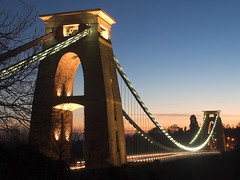
One of the most rewarding aspects of night photography is that you never really know what you are going to get. When shutter speeds start to extend beyond the norm you get some wonderful shifts in light and colour that you will never see with the naked eye.
It is these unknowns that can help to breathe new life into well known and photographed landmarks such as the clifton suspension bridge. It also gives you some great photography options during the winter months where it becomes a bonus that its dark when you leave work.
So how do you go about getting shots like the one above? It's really an extension of the same techniques that you will use for landscapes but of course everything takes a little longer.
Shooting in low light presents some unique problems to the photographer. First and foremost if you want to shoot with small apertures such as f16 & f22 then your shutter speeds are going to be in the region of seconds which of course means you'll need a tripod.
If its the darker side of dusk then i'll generally start in aperture priority at f8 and see what shutter speed i'm getting. Make sure your ISO is as low as possible as at long shutter speeds digital files can get really noisy (grainy) which looks nasty on screen.
Generally the approach is to experiment. Take a shot at f8 and see what you get. With traffic in the shot you'll never get the same shot twice so take loads to increase your chance of getting lucky.
My camera has a noise reduction mode which cleans up the images once they are taken to help to cope with that noise problem I mentioned. This is great but can take ages and hammers the batteries, particularly if its cold. You generally don't have a choice but to use it so make sure you have plenty of spare power.
Exposure is generally trial and error but you can get a good starting point from spot metering off the brighter area of the sky so that you will not burn it out when you shoot. In the shot above I metered from the area above the bridge and bracketed to try adding and removing exposure until I got the effect I wanted.
One vital point is that you'll need to trigger the camera by some sort of remote release or self timer. If its windy take the strap off your camera as this will cause some unsharpness. You should also avoid shutter speeds of between 1/10th - 1" second as the mirror in your slr can also cause some vibration.
The best time to shoot these shots is around dusk. You'll get some great colour in the sky and your shutter speeds will still be manageable. With a bit of natural light around you will find that focussing is so much easier too.
If you want to get a shot like the one above find the slide on the rock on the clifton side of the bridge and you will get some great light in the western sky as the sun drops over Avonmouth.
No comments:
Post a Comment